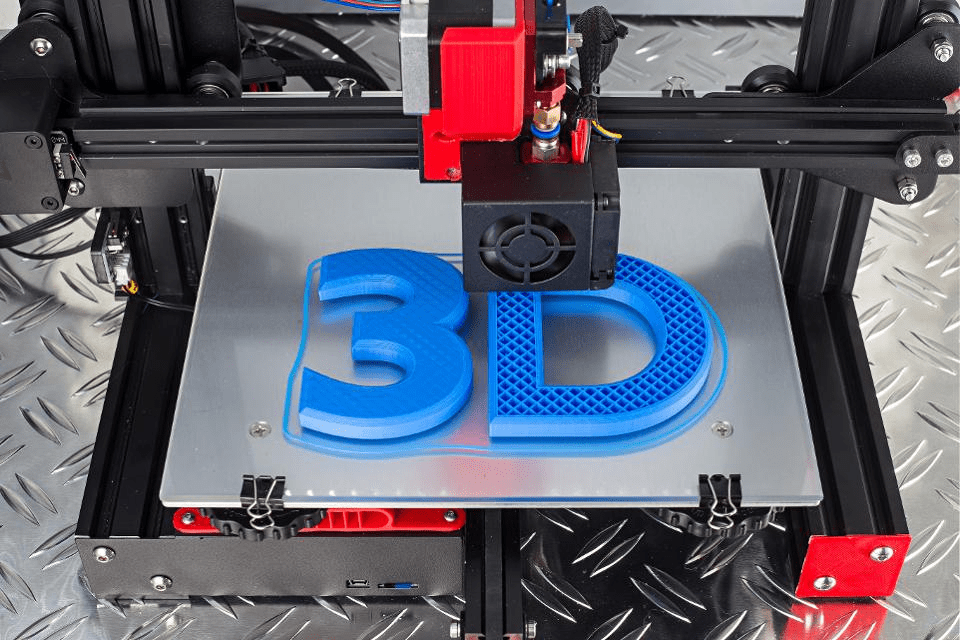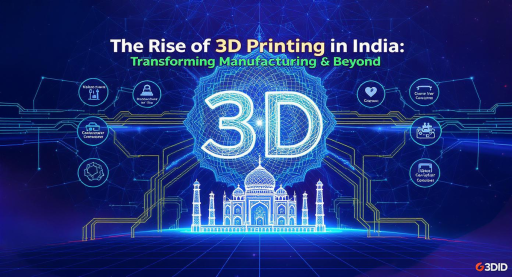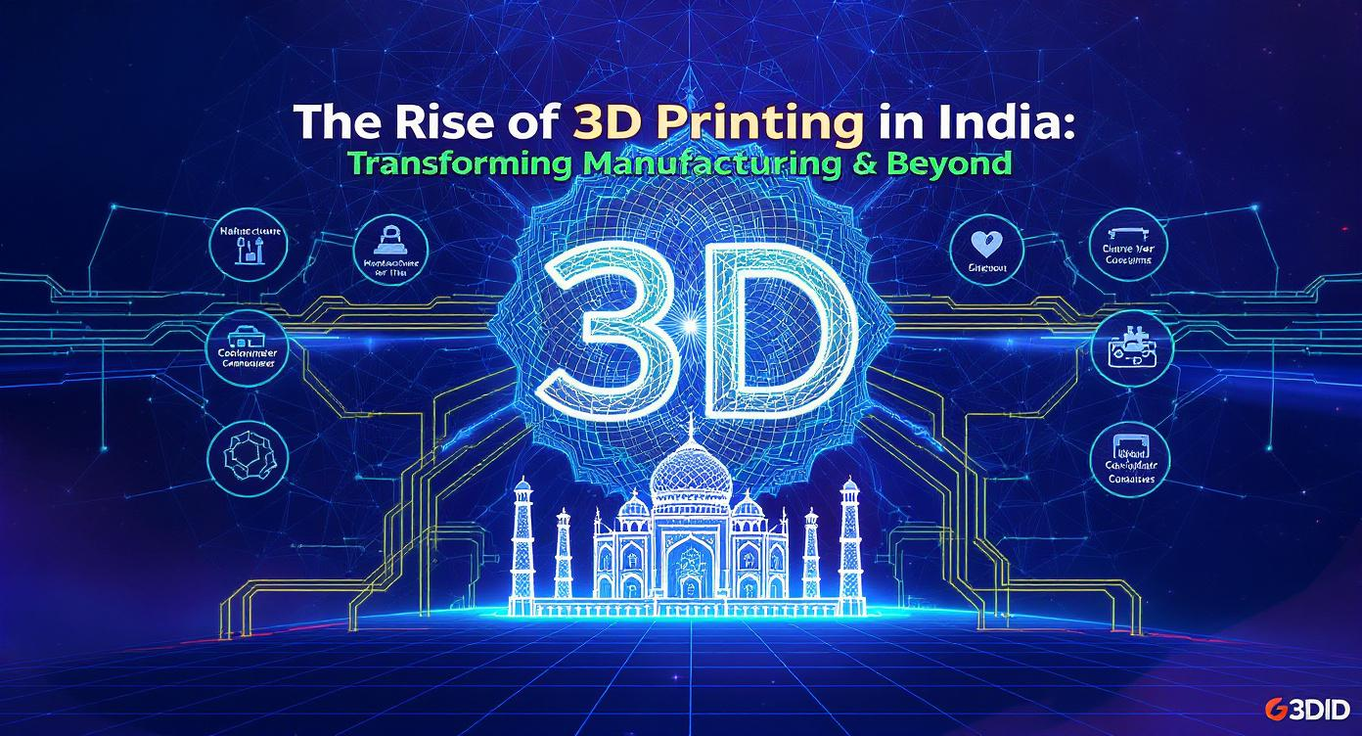India is embracing 3D printing in India at an unprecedented pace, reshaping its industrial landscape with applications of 3D printing across automotive, jewellery, healthcare, construction, aerospace, and more. With over 1,000 domestic players, this nascent additive manufacturing ecosystem is driving innovation and economic growth.
Why 3D Printing in India Is Gaining Momentum
Three-dimensional printing in India has grown from a niche application for prototyping to that of production on a freight scale in a matter of a few years. With the kind of support policies like “Make in India” and the National Strategy on Additive Manufacturing (NSAM) that have been provided, there are now over 1,000 domestic manufacturers and service bureaus in the country.
It is predicted that the market for additive manufacturing will rise to as much as USD 314 million by 2030, with a CAGR of over 26% from 2024 to 2030. The booming growth is a testimony to the increasing investments in 3D printing in India, the rise of local startups like Go3D and Intech Additive, and the rising demand for several applications of 3D printing across different industries.
Domestic Ecosystem and Industry Players
- The Rise of Indian Innovators: Go3D, founded in 2017, is now a leader in 3D printing in India with its indigenous FDM and resin printers.
- Large-format metal 3D printers are the first application of 3D printing in manufacturing realized by Intech Additive Solutions, which actively redefines the field.
- INDO-MIM has partnered with HP to deploy metal printer systems in Bangalore, thereby bolstering 3D printing in India for automotive, aerospace, defence, and other industries.
Policy Framework Giving Support
The government designed the NSAM to help 3D printing in India acquire a 5% share of the global AM market and create 100,000 jobs by 2025. MSMEs in India benefit from technical centres and training through NSIC/NTSC, where they implement applications of 3D printing in electronics, agro, photonics, and medical equipment.

Applications of 3D Printing Across Industries
India’s diversified industrial base showcases applications of 3D printing processes in numerous areas. Additive manufacturing is transforming the key sectors listed below.
Automotive & Transportation
The automotive industry in India utilizes 3D printing for functional prototyping, tool-making, spare parts, and custom components. Firms like Design Roots are providing FDM and SLS services to make lightweight, exact parts with shorter lead times and lower costs.
The applications include:
- Rapid iterations of design through prototype tooling.
- Production of spare parts for vintage and/or low-demand vehicles.
- Reduction of component weight and material consumption for fuel-critical components.
Aerospace & Defence
3D printing in India plays a great role in the aerospace sector. Companies like AgniKul Cosmos 3D-print rocket engines in one go. Aircraft-grade metal components are enabled by INDO-MIM and other metal additive providers. These applications of 3D printing are creating parts that are lighter, more efficient, and more cost-effective in engineering.
Healthcare & Medical Devices
The Indian medical industry is looking into 3D printing in India for everything from educational models to prosthetics:
- AIIMS Bhopal uses patient-specific kidney models and surgical guides.
- Orthopedic, dental, and surgical implants are being custom-manufactured using SLA, FDM, and metal printing.
- Such applications of 3D printing are increasingly improving surgical outcomes while saving time and cutting costs.
Related article: The Role of 3D Printing in Revolutionizing the Industry
Jewellery, Fashion & Consumer Goods
From complex gold jewellery to custom footwear, 3D printing in India has made its mark in consumer design:
- Startups like Imaginarium use 3D-printed wax models for casting jewellery.
- Innovators at NIFT are working on personalized 3D-printed shoe soles using TPU polymers.
- These applications of 3D printing enable complex geometry, mass customization, and rapid time-to-market.
Construction & Affordable Housing
3D printing is an area that has perhaps witnessed one of its greatest impacts in India in construction:
- The 3D-printed building in Kerala, ‘Amaze 28,’ was constructed in 28 days with a labour cost reduction of 75%.
- A concrete extrusion 3D-printed house by Tvasta Technologies took just two weeks.
- The country’s first 3D-printed post office was completed in 45 days by L&T and IIT Madras.
- These applications of 3D printing are transforming affordable housing and urban infrastructure with scalability, sustainability, and cost efficiency.
Nuclear & Energy Sector
The plans for nuclear proliferation in India will utilize printing in India for reactor components, tooling, and fuel-handling systems. This perfectly showcases the versatility of applications of 3D printing in high-precision and regulation-heavy sectors.
Technology Types & Materials
Understanding the technical stack behind 3D printing in India clarifies its far-reaching applications:
- FDM/FFF: General-purpose use in prototyping, tooling, and consumer goods.
- SLA/DLP: Used mainly in high-resolution healthcare and jewellery.
- SLS & SLM: Used mainly in automotive, aerospace, and metal components.
- Concrete extrusion: Used mainly in construction and housing projects.
- Bio-inks: Up-and-coming for bioprinting in healthcare.
Materials ranging from polymers (PLA, nylon, TPU) and metals (steel, titanium, aluminium) to ceramics, concrete, composites, and bio-inks are included. The choice of technology depends on resolution, strength, scale, and material cost—an important criterion for applications of 3D printing in India.
Notable Success Stories
- AgniKul Cosmos – Rocket Engine Made Using 3D Printing: The development of the Agnilet engine has demonstrated that an Indian startup can manufacture an engine completely in a single piece. Its reliability and reduced assembly complexity make it a perfect example of high-end printing in India.
- Intech Additive Metal 3D Printers: Intech’s “iFusion LF” range promises to make large-format, locally supported metal printers with high build rates and reduced costs—a pioneering application of 3D printing in domestic manufacturing.
- AIIMS Bhopal – Surgical Guides: The use of SLA/DLP resin printers for creating models of kidney surgeries and puncture guides at AIIMS Bhopal has increased the precision of surgical procedures—a significant aspect of applying 3D printing in India.
- Amaze 28 – Affordable Housing: This demonstrates how 3D printing in India revolutionizes affordable housing through extrusion-based applications, with houses that can be cost-effectively built in just 28 days.
Find the right business opportunity tailored to your budget and goals
Impact and Advantages
Cost Efficiency & Time Savings
The cost savings and reduced waste materials brought by 3D printing in India can be seen in both Amaze 28 houses and precision implants. Rapid prototyping and efficient functional parts save time-to-market and enable MSMEs to accelerate their innovation cycles.
Personalization & Complex Geometry
3D printing applications include customizing patient-specific anatomy for healthcare, custom jewelry, and stylized consumer goods. It can accommodate intricate lattice structures and complex curves matched to proprietary aesthetics at scale.
Sustainability
Additive Manufacturing minimizes raw material consumption and offsets inefficiencies in supply chains, particularly in construction and energy. Eco-friendly construction and localized production further contribute to reducing the carbon footprint, a critical challenge for Indian urban development.
Challenges Ahead
However, 3D printing in India provides exciting opportunities along with some obstacles:
- Metal printers and bio-inks still have high upfront and maintenance costs.
- Although there is government training for MSMEs, there is still exceptional variability in terms of readiness for technology.
- Regulatory standards are still evolving for certified metal, medical, and structural parts in India.
These challenges need to be addressed through deeper investment, cross-sector collaboration, and well-defined policy frameworks.
Find all of our books here
Future Outlook
India will set out and expand on 3D printing on all fronts:
- Urban infrastructure: Bridges, utility components, and disaster relief shelters through democratized applications of 3D printing.
- Nuclear & defence: Additive components in reactors and weapon platforms.
- Healthcare: 3D bioprinting for tissues and personalized implants, with SLA innovation.
- Aerospace: Promising large-scale uptake of engines and thrust components among startups such as AgniKul.
By 2030, 3D printing would revolutionize applications in the Indian consumer and industrial sectors to include multi-material, multi-colour, and sustainable manufacturing platforms.
Find the Best Idea for Yourself With our Startup Selector Tool
Conclusion
3D printing has emerged as a disruptive force in Industries in India. The application of 3D printing opens up new opportunities in affordable housing, medical implants, aerospace engines, and personalized consumer goods. With robust homegrown innovation, enabling policies, and growing MSME adoption, India is well on its way to becoming a global player in additive manufacturing. 3D printing in India is not merely adopting new modes of technology; it is fostering inclusive, localized growth across the nation while helping it on a sustainable growth path.
For more information, check out this Related video.
Frequently Asked Questions (FAQ)
Q1: Why is 3D printing in India gaining momentum?
A: 3D printing in India has shifted from a prototyping tool to a scalable production technology, powered by supportive policies like “Make in India” and NSAM. Over 1,000 domestic players now drive rapid innovation and adoption across industries.
Q2: What is the expected market growth for 3D printing in India?
A: The Indian additive manufacturing market is projected to reach USD 314 million by 2030, with a CAGR above 26% between 2024 and 2030, fueled by local startups and rising industry demand.
Q3: Which industries are benefitting most from 3D printing in India?
A: Applications of 3D printing span automotive, aerospace, defence, healthcare, construction, nuclear energy, jewellery, and consumer goods, enhancing design flexibility, production speed, and sustainability.
Q4: What are some notable industry success stories in Indian 3D printing?
A: Examples include AgniKul Cosmos’s single-piece rocket engine, Intech Additive’s large metal printers, AIIMS Bhopal’s surgical models, and Amaze 28’s affordable, 3D-printed houses that reduce cost and build times.
Q5: How is the government supporting 3D printing in India?
A: Through the National Strategy on Additive Manufacturing (NSAM), India aims to capture 5% of the global AM market and generate 100,000 jobs by 2025, with subsidies, training, and R&D support for MSMEs and startups.







